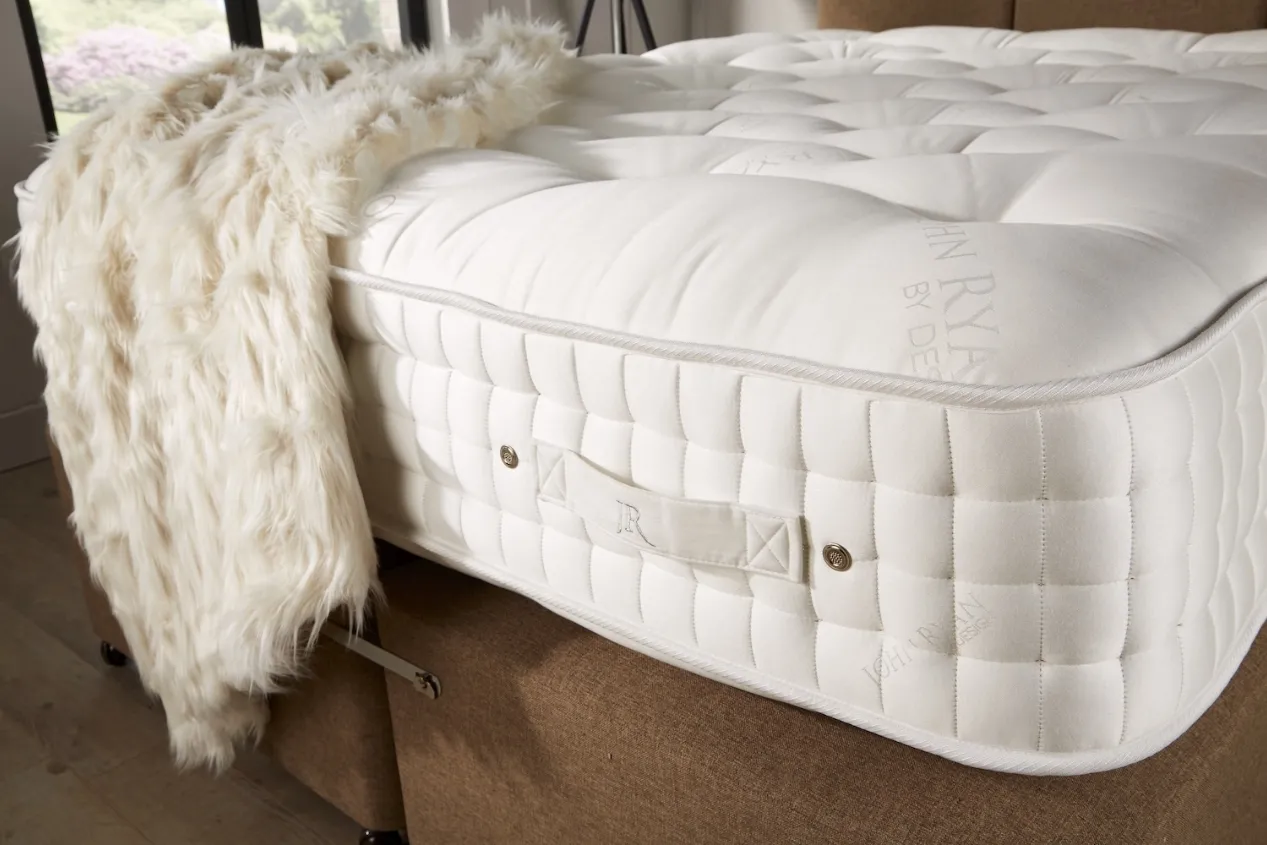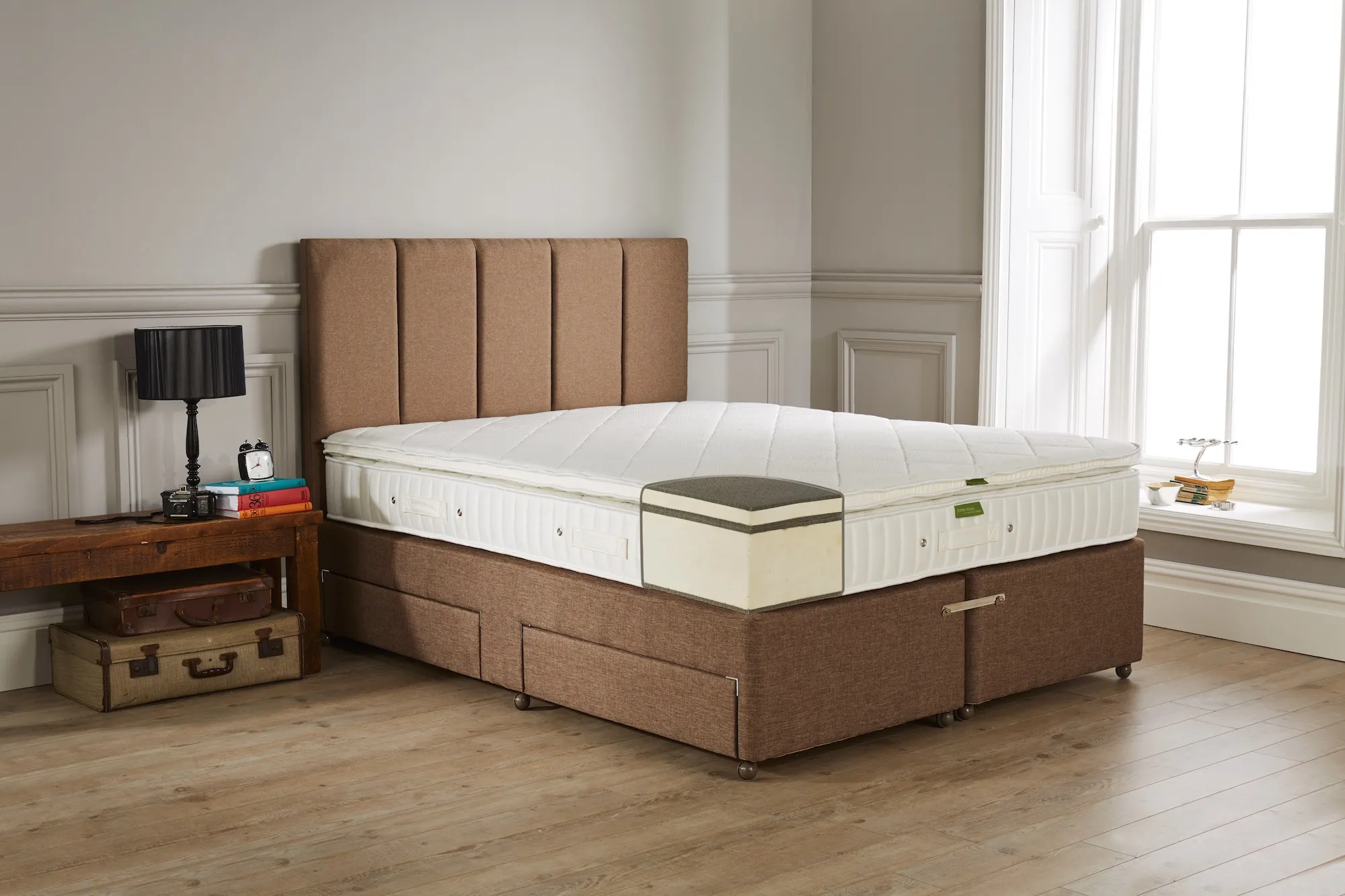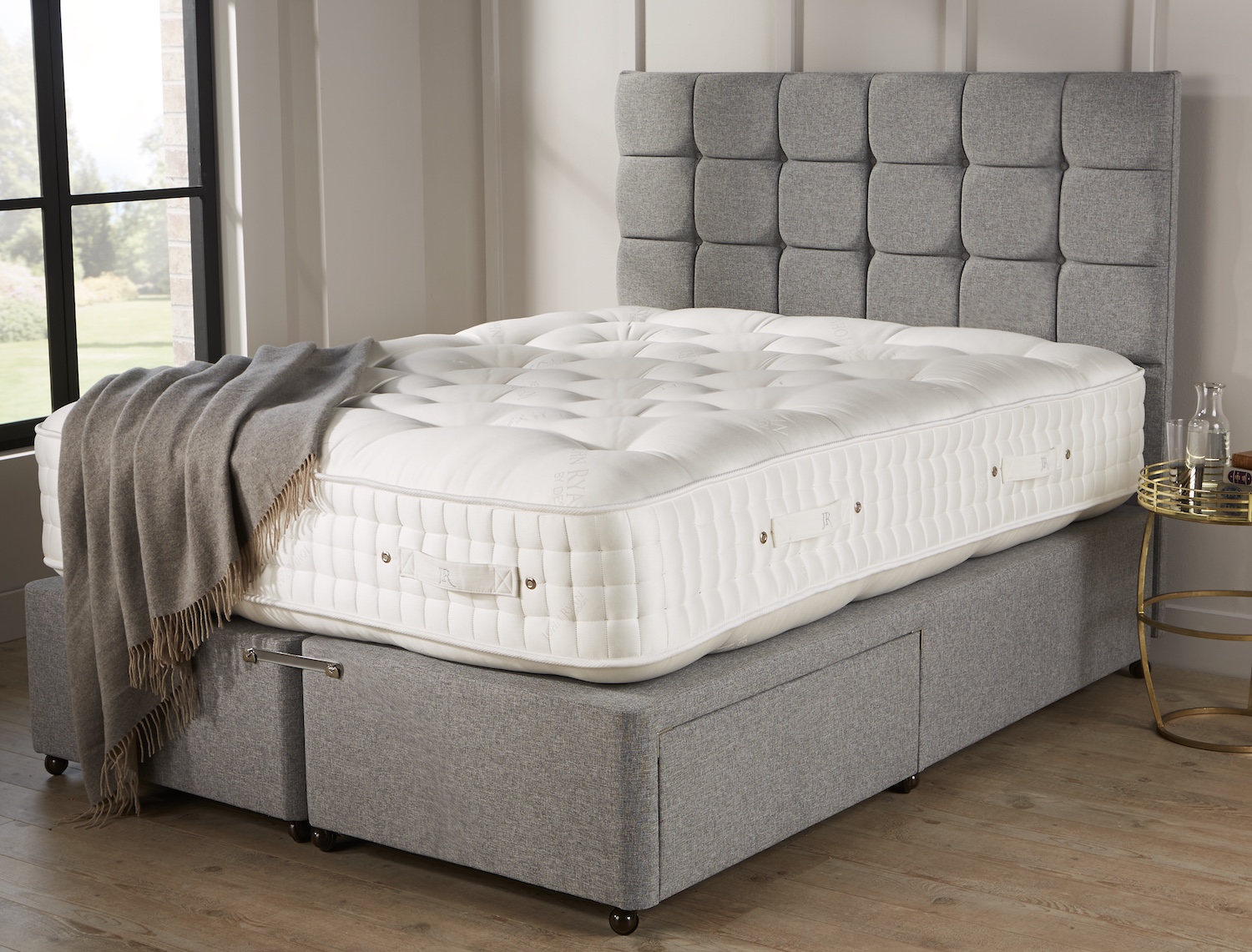Mattress Construction
June 2020Memory Foam mattress: Top 5 Tips for a better night sleep
Some people absolutely swear by memory foam mattresses. They offer an unusual slow sink before holding you in a certain position. Great for people who sleep like a log and don’t need to move about too much in bed. They also retain heat meaning they keep you far warmer at night which is great if you’re a really cold sleeper. They can also be rolled and delivered in a box making the delivery process more convenient for some.

There is a darker side to foam mattresses though and a number of drawbacks that most retailers won’t alert you to. This article will help you see whether or not you can put up with the sacrifices you will make by choosing a memory foam mattress. Here’s our top 5 tips when considering buying a new memory foam mattress.
- Avoid ‘No Turn’ Memory Foam Mattresses
- Memory foam will sag quicker than other materials
- Add a mattress topper to improve memory foam
- Memory foam mattresses will retain more heat
- Why Latex is better than Memory Foam
- How much to spend on a memory foam bed
- How are memory foam beds made?
1. A no-turn memory foam mattress is not a benefit.
When buying a new memory foam mattress you’re going to read a lot about ‘No Turn’ or ‘Turn Free’ mattress models. This is not a benefit to you but actually a drawback.
It’s a requirement of the memory foam construction method for all memory foam beds such as Eve, Casper, LEESA, Emma and Simba to be one-sided. Meaning you can’t turn them and you only get one side’s worth of wear during the lifespan of the mattress. The Memory foam, softer material, sits on top of Reflex foam, firm supportive material, and this makes the mattress one-sided. To turn it would damage the mattress. Don’t be duped into thinking this saves you time. If you’re going to opt for a one-sided mattress make sure you use a topper to help extend the lifespan and even out wear.
2. Memory foam sags far faster than other fibres.
Memory foam is renowned for compressing far quicker than other non-foam fibres such as Polyester, Wool or Horsehair. It is not always a bad thing providing it is minimal and consistent. That’s the key to keeping your new memory foam mattress is great shape.
The cheaper the material the quicker and more prominent the compression. Minimal compression is known as bedding in. A compression that is over the accepted 2cm amount is known as dipping where the bed has failed you.

You should always be looking at 5cm plus for your Memory foam layer so that the compression is minimal. The thinner the layer the more prominent the compression, so a 2cm memory foam layer that compresses by 2cm will fail to have any purpose! This is coupled with the issue that you can’t turn memory foam mattresses so this compression rate becomes really important.
If you have a 2-sided mattress then you have 2 sides to even this wear out on. You can turn and rotate the bed reducing natural settlement and compression. There are thousands of complaints on the web and many in our Ask a Question section about memory foam and boxed foam mattresses sagging within the first year.
Did you know Memory foam will make you sweat more during the night as they retain heat?
Did you also know that memory foam mattress are one-sided. Reducing the lifespan of your mattress?


3. Always add a mattress topper to a memory foam bed
You’ll read all sorts of fancy cover fabrics mattress covers when it comes to memory foam beds. From infrared to anti-dust mite which has little impact on your sleep, the money they cost is best spent elsewhere. A removable fire retardant polyester cover is fine for a Memory foam or Latex mattress since it will be covered by your fitted sheets. You can always take this off and wash it as part of your maintenance routine.
You are better off spending your money on a decent mattress topper with any foam mattress. This is because adding a topper will help address the one-sided mattress issue we discussed above. This topper can be turned and rotated each month helping to even out wear. It also means that you can replace this far more affordably rather than the entire mattress.

Adding a separate topper will also help address the heat issue that many memory foam owners complain about.
4. Memory foam is the warmest mattress type
Many people don’t realise that memory foam and other foams all rely on two things to mould to your body. Pressure and heat. They actively retain heat to keep the foam soft so it can envelop you.
If you’re already a warm sleeper this can result in your bedroom turning into an inferno during the summer months. It also means that you’re likely to sweat far more in memory foam or rolled boxed mattress than a Natural Fibre alternative. Sweat and bodily fluids will degrade the foam over time meaning once again you have a reduced lifespan on your new mattress. Adding a topper can help, but if you’re a warmer sleeper we would always advise choosing a natural fibre breathable mattress instead.

5. Latex Mattresses are a better alternative to memory foam beds
If you like the feeling of memory foam but are put off by excess heat, the issue around one-sided models and the shorter lifespan then Latex may be for you. This Natural Plant-Based Rubber is far more breathable and is two-sided.
Latex compared to memory foam:
- Is far more responsive
- Is a natural plant-based material
- Does not retain as much heat as memory foam
- Allows you to turn and move far easier
- Is two-sided allowing for a longer mattress lifespan
Meaning you can get years more wear out of your mattress. This is why they command a higher price but are ultimately much more durable. Make sure you ask if your Latex mattress is solid core, most are not. If not you’re just buying another one-sided mattress.

How much should I spend on a memory foam mattress?
Memory foam mattresses have started to really creep up in price. Some Tempur models can cost up to £3500! Our guidance is if you’re paying more than £1000 you can find a far better alternative to memory foam moving more towards natural fibre mattresses. These will last far longer offer more advanced comfort and are breathable. We give our top models depending gon your price bracket below.
- What to expect from a £500 Mattress
- What to expect from a £750 Mattress
- What to expect from a £1000 Mattress
- What to expect from a £1500-£2000 Mattress
- What to expect from a £2000 Mattress

| How much to spend on a double mattress? | What can I expect for my money? |
|---|---|
| Under £500 | Will not get you much at best a 13.5 gauge open coil/cage sprung with a thin polyester layer or a solid foam mattress. |
| £500 | Entry level spunbond springs with some form of synthetic upholstery. Usually one sided mattresses. |
| £750 | The beginnings of a basic pocket springs unit with 800 – 1000 count. No substantial amount of filling other than foams and synthetic materials. Two sided models. |
| £1000 | Should get you away from most low ranges and into the mid-range pocket spring models. |
| £1250 | Should get you a decent pocket sprung mattress with some Natural Fibre content. |
| £1500 | Should get you many manufacturers mid-range models with Natural Fibres |
| £1500-£2000 | Should get you a Hand Made primarily Natural Fibre Quality Mattress |
| £2000+ | You should expect 100% Natural Fibres and Traditional Hand Made Construction Method. |
| £5000+ | A Bespoke Hand Made Sleep System, High-end Spring Units & Featuring the Worlds Most Luxurious Natural Fibres. |
How are memory foam mattress made?
The general rule is that a mattress should start off at its firmest at the base and then each layer should get progressively softer, until the topper layer. This allows for progressive comfort and enables the mattress to support you as you sink into each of the layers. If the mattress is too soft for your weight, you will sink quickly down to the firmest layers resting solely on the supportive base. If the mattress is too firm you will simply sit on the top layer without benefiting from the other materials. Both scenarios result in an uncomfortable mattress. The correct mattress will allow you to sink into the layers and equalise, i.e. it is holding, supporting and comforting you just at the right level, not sinking too deep, not resting too high.
Most foam mattresses rely on reflex foam as the ‘support’ layer which is the white foam in the above image. Some foam mattresses may use FEPS and we have an article on that here. The reflex foam is then layered with other softer foams.
It is the foam layers above the reflex foam that you should pay the most attention to understanding their depths and densities is key to fully assess and compare the models you are looking at. There’s an example data sheet for the foams we use that can be used as a comparison to the foams you may encounter. We have a much more detailed article on how to understand depths and densities of foams here.
| Foam Grade | Density Min KG/M3 | Density Max KG/M3 | Hardness Min (n) | Hardness Max (n) |
|---|---|---|---|---|
| Vasco 40kg | 38 | 42 | 40 | 60 |
| Vasco 60kg | 58 | 62 | 70 | 100 |
| Laygel 60kg | 57 | 63 | 100 | 150 |
| Coolblue 70kg | 65 | 70 | 70 | 100 |
| Reflex 300 | 30 | 32 | 100 | 130 |
| Reflex 300F | 30 | 32 | 130 | 160 |
Summary
Buying a new mattress is not a decision you should take lightly. With most of the memory foam models such as Eve, Casper and Tempur starting at around £700 upwards of £3000 you need to make sure you know exactly what you’re getting. If you’re a warmer sleeper you may want to consider a Natural Fibre alternative as a better long term sleep solution.
Why not get in touch with our small friendly team of experts? We can off free mattress advice to help you shortlist the very best next mattress model. Drop us a line below!

Dreaming of the perfect nights sleep?

Ask us a question
There are over 6000 questions and answers submitted by you on all questions about mattresses and bed problems. Enter a keyword such as Vi Spring, John Lewis beds, bad back or Memory Foam and see if your question has already been answered.
If you can’t find an answer in knowledge hub, ask a new question. We aim to respond to all questions within one working day.
Newsletter
Enter your email to join our newsletter. We’ll send you occasional news and mattress expertise.
